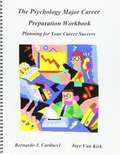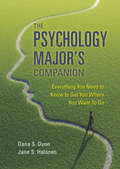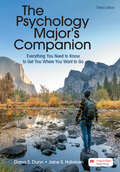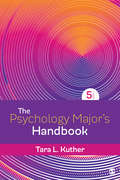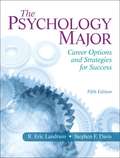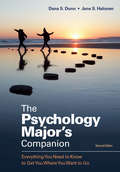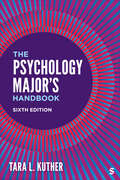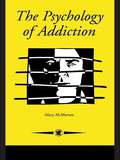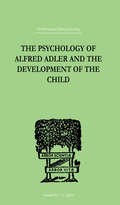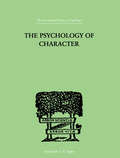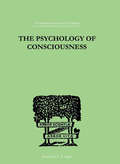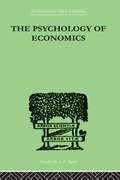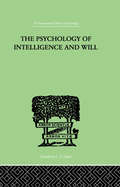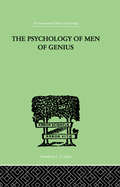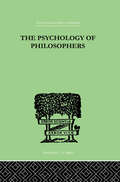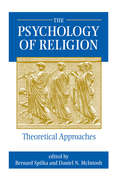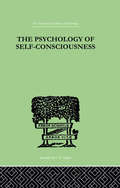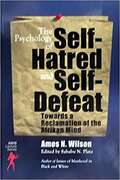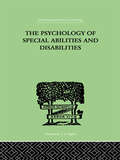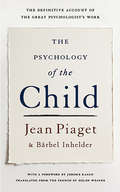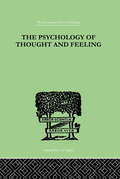- Table View
- List View
The Psychology Major Career Preparation Workbook: Planning for Your Career Success
by Bernardo J. Carducci Jaye Van KirkThe Psychology Major Career Preparation Workbook is designed to help individuals interested in the study of psychology to develop a career plan designed to maximize their probability of employment success.
The Psychology Major's Companion: Everything You Need to Know to Get Where You Want to Go
by Dana S. Dunn Jane S. HalonenWith good advising, hard work, and focused energy, undergraduates majoring in psychology can have before them a future full of amazing possibilities. The objective of this book is to help students to declare the psychology major if it is in their best interests to do so, to learn strategies regarding how to produce optimal gains in the major experience, and to prepare for either graduate school or a psychology-related professional life.<P><P> To create this guide, authors Dunn and Halonen drew extensively on experiences with their own students, as well as interactions with colleagues, especially those who are active in the Society for the Teaching of Psychology (Division 2 of the American Psychological Association).
The Psychology Major's Companion: Everything You Need to Know to Get You Where You Want to Go
by Dana S. Dunn Jane S. HalonenThe Psychology Major’s Companion, Third Edition gives prospective and current psychology majors a roadmap for planning a career, letting them know what to expect from the undergraduate major, the larger discipline, and the marketplace beyond campus. Professors Dunn and Halonen include helpful skill-related tips, how to decide on options for course study, and how to apply to graduate school or get a job with an undergraduate degree.
The Psychology Major's Handbook
by Dr. Tara L. KutherThe Psychology Major’s Handbook offers students a wealth of practical information to succeed throughout their college journey—from choosing a major and learning how to study to writing papers and deciding what to do after graduation. Drawing on over 20 years of experiences, questions, ideas, and enthusiasm from working with students, best-selling author Tara L. Kuther covers topics relevant to all learners regardless of major, such as developing an active learning style, honing study skills, and becoming more self-aware. The handbook also addresses the specific needs of psychology students with guidance on the process of writing terms papers, how to read articles, and how to write APA-Style empirical reports. Thoroughly revised, the Fifth Edition emphasizes psychological literacy and pays particular attention to the role of technology and social media in students' lives.
The Psychology Major's Handbook
by Dr. Tara L. KutherThe Psychology Major’s Handbook offers students a wealth of practical information to succeed throughout their college journey—from choosing a major and learning how to study to writing papers and deciding what to do after graduation. Drawing on over 20 years of experiences, questions, ideas, and enthusiasm from working with students, best-selling author Tara L. Kuther covers topics relevant to all learners regardless of major, such as developing an active learning style, honing study skills, and becoming more self-aware. The handbook also addresses the specific needs of psychology students with guidance on the process of writing terms papers, how to read articles, and how to write APA-Style empirical reports. Thoroughly revised, the Fifth Edition emphasizes psychological literacy and pays particular attention to the role of technology and social media in students' lives.
The Psychology Major's Handbook Fourth Edition
by Tara L. KutherThe book provides you with the facts and insights you need to make informed decisions about whether to pursue psychology as a major and career, as well as useful tips to help you succeed as a psychology major.
The Psychology Major: Career Options and Strategies for Success
by Stephen F. Davis R. Eric LandrumThis text standardizes and catalogs much of the practical advice that professors often give to students--providing tips on how to do well in all classes, how to find research ideas, and how to write papers in general APA format. <p><p> Also, the book contains up-to-date career information that faculty might not normally have at their fingertips, including the latest salary figures for a number of psychology-related jobs and occupations.
The Psychology Major’s Companion: Everything You Need To Know To Get Where You Want To Go
by Dana Dunn Jane HalonenDesigned to help both prospective and current psychology majors know what to expect from the undergraduate major, the larger discipline, and the marketplace beyond campus, The Psychology Major's Companion, Second Edition gives students a map to planning their career in psychology. The authors include helpful skill-related tips, how to decide on options for course study, and how to apply to graduate school or get a job with an undergraduate degree.
The Psychology Major′s Handbook
by Tara L. KutherResearch shows that today′s students are unique. Whether anxious, overwhelmed, or too busy to ask for help, modern students trust and turn to the resources at their fingertips for guidance. Tara Kuther created The Psychology Major′s Handbook for this purpose, to bridge the gap between advisor and manual. Created to support and follow along with a student through college, this text provides the support of an advisor as students navigate choosing a major, learning how to study, writing papers, and deciding what to do after college. Within each chapter, Kuther supports learners in applying concepts to their own lives through embedded exercises. The updated Sixth Edition encourages students to take an active role in their education and explains all of the ways that students can influence their own college experiences. Three individual chapters emphasize academics and cover crucial study and college skills, such as writing a review paper, and an APA Style empirical paper. The final four chapters of the text focus on bachelor′s and graduate opportunities to help students to look past graduation.
The Psychology Major′s Handbook
by Tara L. KutherResearch shows that today′s students are unique. Whether anxious, overwhelmed, or too busy to ask for help, modern students trust and turn to the resources at their fingertips for guidance. Tara Kuther created The Psychology Major′s Handbook for this purpose, to bridge the gap between advisor and manual. Created to support and follow along with a student through college, this text provides the support of an advisor as students navigate choosing a major, learning how to study, writing papers, and deciding what to do after college. Within each chapter, Kuther supports learners in applying concepts to their own lives through embedded exercises. The updated Sixth Edition encourages students to take an active role in their education and explains all of the ways that students can influence their own college experiences. Three individual chapters emphasize academics and cover crucial study and college skills, such as writing a review paper, and an APA Style empirical paper. The final four chapters of the text focus on bachelor′s and graduate opportunities to help students to look past graduation.
The Psychology Of Addiction
by Mary McMurranThis text provides a comprehensive overview of psychological approaches to understanding addictions. Without denying the importance of biological Factors, Emphasis Is Placed More Upon Social, Psychological And Emotional factors as is necessary to a complete understanding of addiction. Within this framework, an addiction is not limited to substance-based behaviours such as drinking alcohol, smoking or drug use. Although these important areas are covered, a wider perspective is taken to include behavioural addictions such as gambling, violence and joy riding. Finally, prevention approaches are discussed with reference to the public health model which encompasses issues relating to the agent, the host and the environment. A list of resources and references is provided for those wishing to obtain further information.; Written in a jargon-free style, "The Psychology of Addiction" is aimed at students at the beginning of their courses. It should also be a valuable resource for professionals: nurses, social workers, police and probation officers and medical students, who often encounter the problems described in the book.
The Psychology Of Alfred Adler: and the Development of the Child (International Library Of Psychology Ser.)
by Ganz, MadelaineFirst Published in 1999. Routledge is an imprint of Taylor & Francis, an informa company.
The Psychology Of Character: WITH A SURVEY OF PERSONALITY IN GENERAL (Classics In Psychology Ser.)
by Roback, A AFirst Published in 1999. Routledge is an imprint of Taylor & Francis, an informa company.
The Psychology Of Consciousness (International Library Of Psychology Ser. #Vol. 16)
by King, C DalyFirst Published in 1999. Routledge is an imprint of Taylor & Francis, an informa company.
The Psychology Of Economics (International Library Of Psychology Ser.)
by Weisskopf, Walter AFirst Published in 1999. This book is a study of psychology and philosopy of social thought, exemplified by the analysis of certain economic ideas. The method is briefly sketched in the first part and then applied in a series of case studies to crucial concepts in economics.
The Psychology Of Intelligence And Will
by Wyatt, H GFirst Published in 1999. Routledge is an imprint of Taylor & Francis, an informa company.
The Psychology Of Men Of Genius (International Library Of Psychology Ser.)
by Kretschmer, ErnstFirst Published in 1999. Routledge is an imprint of Taylor & Francis, an informa company.
The Psychology Of Moral Development: The Nature and Validity of Moral Stages (Essays On Moral Development #Vol. 2)
by Lawerence KohlbergThe Psychology of Moral Development: The Nature and Validity of Moral Stages
The Psychology Of Philosophers (International Library Of Psychology)
by Herzberg, AlexanderFirst Published in 1999. Routledge is an imprint of Taylor & Francis, an informa company.
The Psychology Of Religion: An Empirical Approach
by Bernard SpilkaTheory in the psychology of religion is in a state of rapid development, and the present volume demonstrates how various positions in this field may be translated into original foundational work that will in turn encourage exploration in many directions. A number of new contributions are collected with previously published pieces to illustrate the
The Psychology Of Self-Conciousness
by Turner, JuliaFirst Published in 1999. Routledge is an imprint of Taylor & Francis, an informa company.
The Psychology Of Self-hatred And Self-defeat: Towards A Reclamation Of The Afrikan Mind
by Amos N. Wilson Sababu N. PlataThe Psychology of Self-Hatred and Self-Defeat: Towards a Reclamation of the Afrikan Mind
The Psychology Of Special Abilities And Disabilities
by Bronner, Augusta FFirst Published in 1999. Routledge is an imprint of Taylor & Francis, an informa company.
The Psychology Of The Child: Classification And Seriation (International Library Of Psychology Ser.)
by Jean Piaget Barbel InhelderThe definite account of psychologist Jean Piaget's work Jean Piaget's influence on psychology has been profound. His pathbreaking investigations and theories of cognitive development have set child psychology moving in entirely new directions. His bold speculations have provided the inspiration for the work of others. His studies have been the subject of many books and countless articles. And, significantly, his influence has spread to other disciplines and is having an ever-growing impact on the general culture at large.Here Jean Piaget, with the assistance of his long-time collaborator Bärbel Inhelder, offers a definitive presentation of the developmental psychology he has elaborated over the last forty years. This comprehensive synthesis traces each stage of the child's cognitive development, over the entire period of childhood, from infancy to adolescence.
The Psychology Of Thought And Feeling: A Conservative Interpretation of Results in Modern Psychology (International Library Of Psychology Ser.)
by Platt, CharlesFirst Published in 1999. Routledge is an imprint of Taylor & Francis, an informa company.
